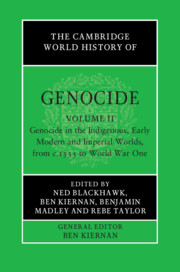Book contents
- The Cambridge World History of Genocide
- The Cambridge World History of Genocide
- The Cambridge World History of Genocide
- Copyright page
- Contents
- Figures
- Maps
- Tables
- Contributors to Volume ii
- Introduction to Volume ii
- Part I Settler Colonialism
- Part II Empire-Building and State Domination
- Part III Nineteenth-Century Frontier Genocides
- Part IV Premonitions
- 22 Genocide and the Forcible Removal of Aboriginal Children in Australia, 1800–1920
- 23 The Killing Fields of Jiangnan
- 24 The Crime of the Congo
- 25 The Ottoman Massacres of Armenians, 1894–1896 and 1909
- 26 ‘Rivers of Blood and Rivers of Money’
- 27 Representations of the Poison Gas War on the Eastern Front, 1915–1917
- Index
26 - ‘Rivers of Blood and Rivers of Money’
The Herero and Nama Genocides in German Southwest Africa, 1904–1908
from Part IV - Premonitions
Published online by Cambridge University Press: 23 June 2023
- The Cambridge World History of Genocide
- The Cambridge World History of Genocide
- The Cambridge World History of Genocide
- Copyright page
- Contents
- Figures
- Maps
- Tables
- Contributors to Volume ii
- Introduction to Volume ii
- Part I Settler Colonialism
- Part II Empire-Building and State Domination
- Part III Nineteenth-Century Frontier Genocides
- Part IV Premonitions
- 22 Genocide and the Forcible Removal of Aboriginal Children in Australia, 1800–1920
- 23 The Killing Fields of Jiangnan
- 24 The Crime of the Congo
- 25 The Ottoman Massacres of Armenians, 1894–1896 and 1909
- 26 ‘Rivers of Blood and Rivers of Money’
- 27 Representations of the Poison Gas War on the Eastern Front, 1915–1917
- Index
Summary
Between 1904 and 1908 an estimated 80% of the Herero and half of the Nama population, in total some 75,000 men, women and children, lost their lives in German South-West Africa, present-day Namibia. They were killed by German soldiers, died in concentration camps, or perished in the desert after being chased away from their homelands. The genocides were a culmination of years of ruthless and forceful German dispossession of Herero and Nama land and property. This chapter focuses on the racial prejudice and fear of the Other at the root of the Herero and Nama genocides. Since the founding of the protectorate in 1884, Germans aimed to brutally subjugate the Herero and Nama peoples. Notions of racial superiority that attempted to justify taking Indigenous land and acts of violence against the colonized had always been balanced by a fear of anticolonial violence. Even prior to the genocide, this led to ever-greater atrocities, including the genocidal Hoornkrans Massacre (1893) and the incarceration of the Khauas-Khoi in concentration camps (1896). The chapter argues that racism and dehumanization shaped the events taking place before, during and directly after the genocide, which was long forgotten as a mere ‘colonial war’.
Keywords
- Type
- Chapter
- Information
- The Cambridge World History of Genocide , pp. 634 - 656Publisher: Cambridge University PressPrint publication year: 2023

